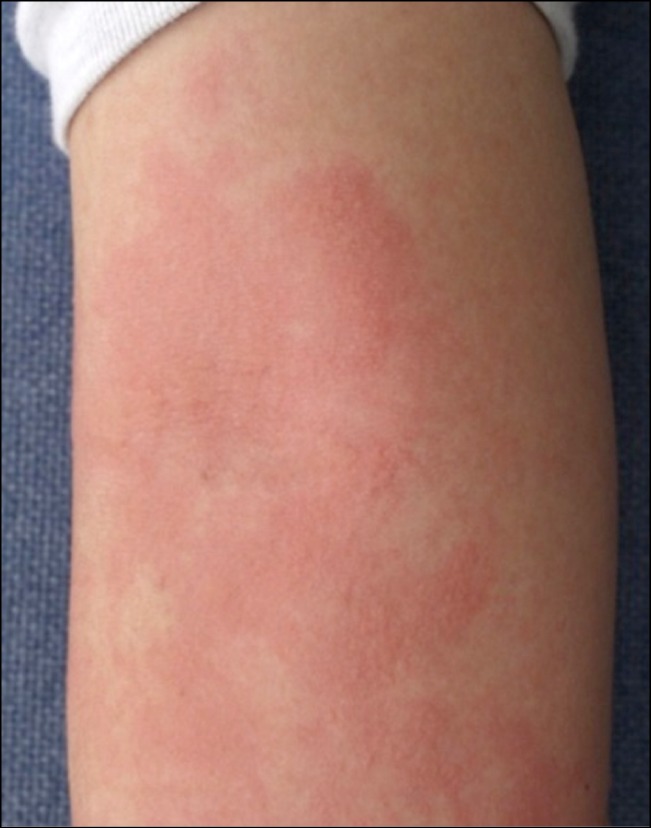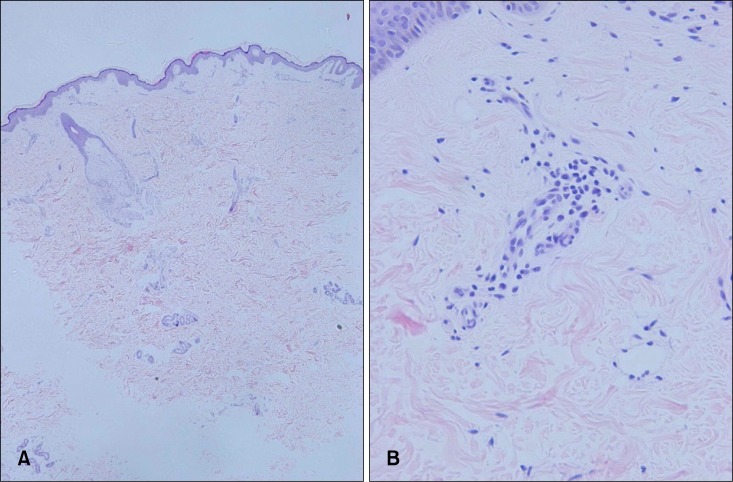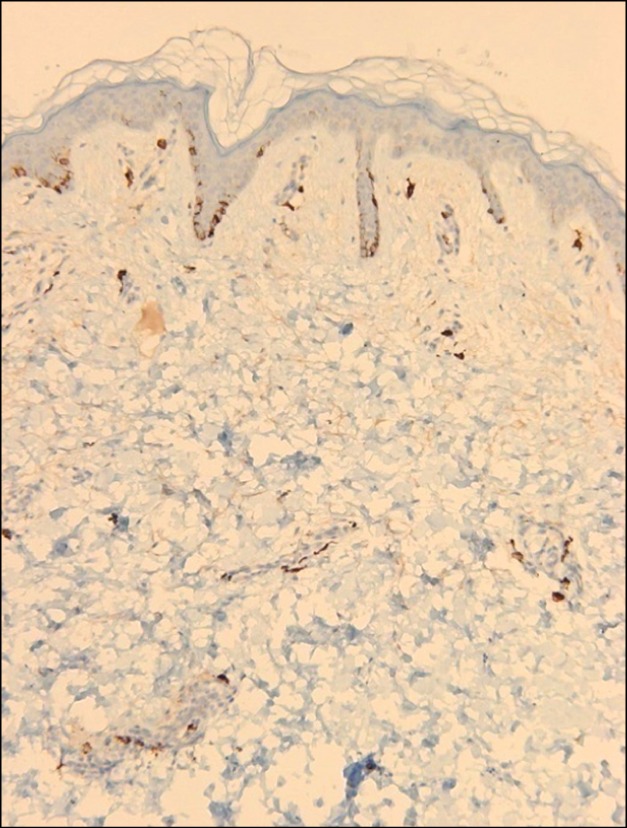Ann Dermatol.
2017 Jun;29(3):341-345. 10.5021/ad.2017.29.3.341.
Aquagenic Urticaria Diagnosed by the Water Provocation Test and the Results of Histopathologic Examination
- Affiliations
-
- 1Department of Dermatology, Busan Paik Hospital, Inje University College of Medicine, Busan, Korea. derma09@hanmail.net
- KMID: 2378537
- DOI: http://doi.org/10.5021/ad.2017.29.3.341
Abstract
- An 18-year-old male visited our department complaining of recurrent episodes of an itchy rash after hand washing, showering/bathing, drinking water, and getting rain-soaked. He was diagnosed with aquagenic urticaria after a water provocation test and histopathologic examination. Five months of antihistamine treatment successfully prevented further wheal formation. Aquagenic urticaria is a very unusual form of physical urticaria caused by contact with water. It manifests as pruritic small wheals surrounded by erythema within 30 minutes of exposure. The condition can be diagnosed by a water provocation test. Systemic antihistamines are the first-line treatment, with anticholinergics, phototherapy, or barrier cream used alternatively or additionally. Four cases of aquagenic urticaria have been reported in Korea, but no histopathologic evaluation was reported in the English or Korean literature. Herein, we provide both a case report of aquagenic urticaria diagnosed by the water provocation test and histopathologic examination results for this patient.
Keyword
MeSH Terms
Figure
Reference
-
1. Shelly WB, Rawnsley HM. Aquagenic urticaria. Contact sensitivity reaction to water. JAMA. 1964; 189:895–898. PMID: 14172902.2. Yavuz ST, Sahiner UM, Tuncer A, Sackesen C. Aquagenic urticaria in 2 adolescents. J Investig Allergol Clin Immunol. 2010; 20:624–625.3. Czarnetzki BM, Breetholt KH, Traupe H. Evidence that water acts as a carrier for an epidermal antigen in aquagenic urticaria. J Am Acad Dermatol. 1986; 15:623–627. PMID: 2429997.
Article4. Sibbald RG, Black AK, Eady RA, James M, Greaves MW. Aquagenic urticaria: evidence of cholinergic and histaminergic basis. Br J Dermatol. 1981; 105:297–302. PMID: 7272209.
Article5. Magerl M, Borzova E, Giménez-Arnau A, Grattan CE, Lawlor F, Mathelier-Fusade P, et al. The definition and diagnostic testing of physical and cholinergic urticarias--EAACI/GA2LEN/EDF/UNEV consensus panel recommendations. Allergy. 2009; 64:1715–1721. PMID: 19793059.6. Bonnetblanc JM, Andrieu-Pfahl F, Meraud JP, Roux J. Familial aquagenic urticaria. Dermatologica. 1979; 158:468–470. PMID: 38152.
Article7. Davis RS, Remigio LK, Schocket AL, Bock SA. Evaluation of a patient with both aquagenic and cholinergic urticaria. J Allergy Clin Immunol. 1981; 68:479–483. PMID: 7310013.
Article8. Gimenez-Arnau A, Serra-Baldrich E, Camarasa JG. Chronic aquagenic urticaria. Acta Derm Venereol. 1992; 72:389. PMID: 1361294.9. Kim CH, Ryu ST, Park SW, Lee JH, Oh WS, Chang SI, et al. A case of the coexistence of cold urticaria and aquagenic urticaria. Korean J Asthma Allergy Clin Immunol. 2004; 24:350–352.10. Luong KV, Nguyen LT. Aquagenic urticaria: report of a case and review of the literature. Ann Allergy Asthma Immunol. 1998; 80:483–485. PMID: 9647271.
Article11. Parker RK, Crowe MJ, Guin JD. Aquagenic urticaria. Cutis. 1992; 50:283–284. PMID: 1424795.12. Kai AC, Flohr C. Aquagenic urticaria in twins. World Allergy Organ J. 2013; 6:2. PMID: 23663417.
Article13. Juhlin L, Malmros-Enander I. Familial polymorphous light eruption with aquagenic urticaria: successful treatment with PUVA. Photodermatol. 1986; 3:346–349. PMID: 3588355.14. McGee JS, Kirkorian AY, Pappert AS, Milgraum SS. An adolescent boy with urticaria to water: review of current treatments for aquagenic urticaria. Pediatr Dermatol. 2014; 31:116–117. PMID: 22994854.
Article15. Seize MB, Ianhez M, de Souza PK, Rotta O, Cestari Sda C. Familial aquagenic urticaria: report of two cases and literature review. An Bras Dermatol. 2009; 84:530–533. PMID: 20098859.16. Lee HG, Lee AY, Lee YS. A case of aquagenic urticaria. Korean J Dermatol. 1990; 28:456–458.17. Park H, Kim HS, Yoo DS, Kim JW, Kim CW, Kim SS, et al. Aquagenic urticaria: a report of two cases. Ann Dermatol. 2011; 23(Suppl 3):S371–S374. PMID: 22346281.
Article18. Mobini N, Toussaint S, Kamino H. Noninfectious erythematous, papular, and squamous diseases. In : Elder DE, Elenitsas R, Johnson BL, Murphy GF, Xu X, editors. Lever's histopathology of the skin. 10th ed. Philadelphia: Lippincott Williams & Wilkins;2008. p. 169–203.19. Velazquez EF, Murphy GF. Introduction to dermatopathologic diagnosis. In : Elder DE, Elenitsas R, Johnson BL, Murphy GF, Xu X, editors. Lever's histopathology of the skin. 10th ed. Philadelphia: Lippincott Williams & Wilkins;2008. p. 7–66.20. Gollhausen R, Kaidbey K, Schechter N. UV suppression of mast cell-mediated wealing in human skin. Photodermatol. 1985; 2:58–67. PMID: 4041035.




